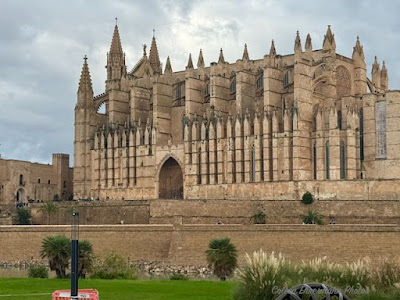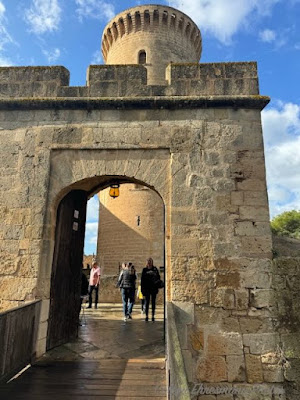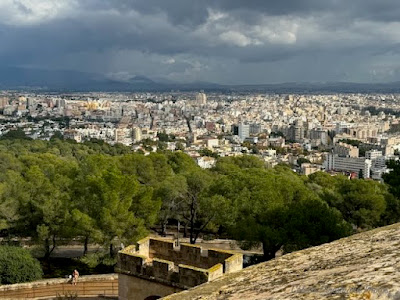Palma is a resort city and capital of the Spanish island of Mallorca (Majorca), in the western Mediterranean. The massive Santa María cathedral, a Gothic landmark begun in the 13th century, overlooks the Bay of Palma. The adjacent Almudaina is a Moorish-style Arab fortress converted to a royal residence. West of the city, hilltop Bellver Castle is a medieval fortress with a distinctive circular shape. ― Google
We chose to ride the Hop On-Hop Off bus for the excursion in Palma. OFD had done the research and the Santa María Cathedral and the Bellver Castle were on the list of places to see and explore.
the view of Santa María from the street
climbing the stone steps to enter the fortress protecting the cathedral
the rear of the cathedral
and across the plaza, the entrance to the Moorish fortress/royal residence
(we chose not to go through the royal residence)
entrance to the cathedral
but it was Sunday and open only for mass
through a door around the corner
detailing above the entrance door
the front of the cathedral as seen from the Ho Ho bus
9 flying buttresses to support the walls of the building
the Moorish fortress/royal residence is the structure to the far left
shops were along the far side of the cathedral connecting the cathedral and the fortress
Because the cathedral was not open for viewing, we headed up the hill to the Bellver Castle, one of the few remaining round castles in Europe.
Because it was a Sunday, the Bellver Castle entrance fee of $4.20 was waived. What a deal!
Bellver Castle is a Gothic-style castle built in the 14th century for King James II of Majorca. It was the first circular castle in Europe.
castle entrance
two walls of protection
inner moat
our view when we entered the castle
Having been founded as a seat for the royal court of James of Mallorca, its structure combines the needs of a palace with defensive elements. The most notable feature in its structure is its circular shape, unique in Mallorca. Both its surrounding wall and the inner yard are so-shaped, and so are the three minor towers and the donjon. A moat is found surrounding the castle and its donjon. ~ Wikipedia
the ceiling of the upper level walkway
The Castle has clear Islamic influences in its original design, displaying double Arches characteristic of Moorish architecture. ~ Wikipedia
one of the museum displays in the castle
the city of Palma from the castle
The palace itself is structured as a two-story building around the central yard. All its dependencies face this yard through a gallery of gothic semi-circular arches. ~ Wikipedia
the floor of the walkway and center courtyard
a well in the center of the courtyard
one of the defensive elements
In 1931, the Spanish Second Republic gave the castle to the city of Palma, along with the forest surrounding it. It became a museum in 1932, being restored in 1976 to become the city's History museum. ~ Wikipedia
outer moat
First serving as the residence of the Kings of Majorca, and afterward long used as a military prison throughout the 18th to mid-20th century, it is now under civilian control, being one of the main tourist attractions of the island, as well as the seat for the city's History Museum. ~ Wikipedia
























No comments:
Post a Comment
Thanks for your comments!